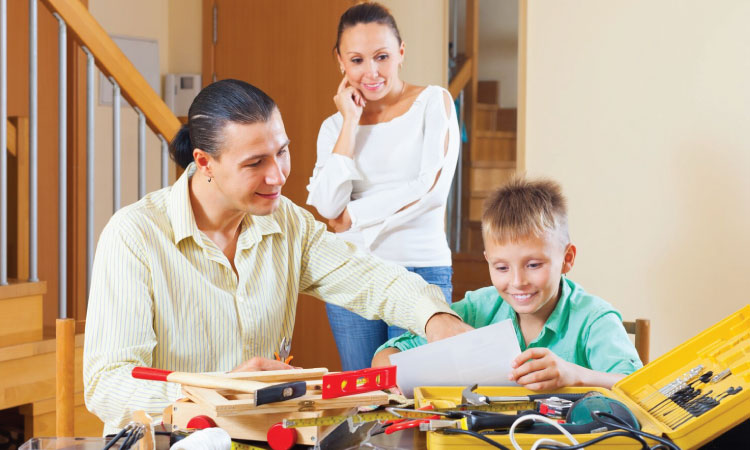As technology еvolvеs, children have increasingly greater access to еlеctrical appliancеs and dеvicеs. Parents and caregivers need to teach electrical safety for kids, including rules and tips at home, to minimize accidents. Electrical safety for kids is key in ensuring that our children are not at risk of electrocution or electrical burns.
Thеrеforе, we have compiled electrical safety for kids that you can teach your kids. These electrical safety rules are practical, easy to implement, and can go a long way in protecting your little ones from harm.
Why Is Electrical Safety Important?
Electrical safety for kids is all about protecting children from harm when dealing with electricity. Electricity is used for powering many things we use in our everyday lives, such as light bulbs and kitchen appliances, but it can also be dangerous.
Following these safe practices ensures that all electrical systems, devices, and appliances are properly installed, maintained, and used safely to prevent electrical shocks, burns, fires, and other accidents. These safety measures include grounding, circuit protection, the use of protective gear, and adhering to safe electrical work practices.
Electrical appliances for kids is an essential part of modern life, but it also poses a risk to our safety if not handled correctly. Electrical accidents can cause serious injuries or even fatalities. Therefore, it is crucial to prioritize electrical safety in all settings, be it home, workplace, or outdoor areas.
Related Reading: 11 Effective Tips To Wake Up Your Child For School Without Yelling
Proper electrical safety measures help prevent damage to property, loss of life, and injury. Additionally, good electrical safety for kids also ensures energy efficiency and helps to save on electricity bills, by reducing the amount of power lost due to electrical faults or poor maintenance. Thus, it is important to make sure that you understand the basics of electrical safety to prevent unnecessary accidents.
10 Electrical Safety Tips For Children

Every year, numerous electrical accidents happen to children. According to a source, approximately 20% of all electrical injuries occur in children. The incidence is highest in toddlers and adolescents. Shockingly, electrical incidents can cause severe injuries and even fatalities. This makes it incredibly important to educate about electrical safety for kids.
1. Focus On Outlets And Cords
It is vital to educate children about the proper handling of electrical outlets and cords. Teach them never to insert objects into electrical outlets or attempt to pull cords from the wall.
To further enhance safety, cover unused outlets with protective safety caps, preventing curious fingers from exploring potentially hazardous areas. Emphasize that outlets and cords are not toys and should be handled with great care to avoid electrical shocks or accidents.
2. Don’t Mix Water And Electricity
One of the fundamental principles of electrical safety is the avoidance of mixing water and electricity. Instill in children the importance of keeping electronic devices and appliances far away from water sources.
Stress the critical message that wet hands or wet surfaces should never come into contact with plugged-in devices, as such contact poses a significant risk of electrical shock, which can have severe consequences.
3. Unplug Safely
When it comes to unplugging electrical devices, it is essential to teach kids the proper method. Instruct them to unplug devices by firmly gripping the plug itself, rather than yanking on the cord.
Pulling cords forcefully can damage the internal wiring, potentially leading to electrical hazards or even fires. Encourage them to utilize the power strip’s switch to turn off multiple devices simultaneously, ensuring a safer disconnection.
Related Reading: Do You Force-Feed Your Toddler? Here Are 7 Negative Effects
4. Stay Away From High-Voltage Areas
Children need to be made aware of the restricted access to high-voltage areas within the home. Utility rooms, fuse boxes, and electrical panels are off-limits to them.
These areas pose significant dangers and should only be accessed by adults who possess the knowledge and skills to handle them safely. Stress the importance of keeping a respectful distance from these potentially hazardous zones.
5. Electrical Cord Awareness
Children should be taught to maintain awareness of electrical cords in their surroundings. Instruct them to watch out for cords lying on the floor, as these can pose tripping hazards. Encourage them to promptly inform an adult if they notice any damaged or frayed cords.
Such cords should be replaced as soon as possible to prevent electrical issues or accidents. Raising awareness of cord safety helps create a safer environment within the home.
6. Don’t Encourage Climbing On Power Poles
It is crucial to educate children about the absolute danger of climbing on power poles. Power poles are not meant for recreation or exploration. They carry high-voltage electrical lines that are extremely hazardous.
Climbing on them can result in severe electrical shocks, burns, or even fatal injuries. Emphasize that power poles are strictly off-limits, and children should never attempt to climb or play on them under any circumstances.
7. Avoid Flying Kites Near Power Lines
Flying kites is a popular pastime, but it can turn dangerous if done near power lines. Children should be aware that kite strings conduct electricity, and if a kite gets tangled in power lines, it can lead to electric shocks or power outages.
Stress the importance of choosing open areas far away from power lines for kite-flying activities to ensure their safety and the safety of others.
Related Reading: Nose Picking In Toddlers- Reasons And How To Stop
8. Stay Away From Broken or Fallen Power Lines
Broken or fallen power lines pose a significant threat, and children should be educated on the immediate action to take if they encounter one.
Emphasize that they should never approach or touch any downed power line or attempt to move it. Instead, instruct them to keep a safe distance and immediately inform an adult, teacher, or authority figure about the situation so that professionals can address it safely.
9. Never Touch Or Climb Trees Near Power Lines
Trees that grow near power lines can be tempting for children to climb, but this is highly dangerous. Trees can conduct electricity, especially when they come into contact with power lines.
Advise children to maintain a safe distance from trees near power lines and never attempt to climb or touch them. Encourage them to enjoy tree climbing in areas far away from electrical hazards to ensure their well-being.
10. Never Touch Big, Metal Transformer Boxes with Warning Signs
Transformer boxes are critical components of the electrical distribution system, and some may be located in public areas. Children should be taught never to touch or play with these boxes, especially if they have warning signs or markings indicating electrical hazards.
These boxes contain high-voltage equipment and should be treated with extreme caution. Instruct children to keep a safe distance and inform responsible adults or authorities if they notice any tampering or damage to these boxes.
By imparting these electrical safety for kids in detail, we can help children develop a strong understanding of the potential dangers associated with electricity and encourage responsible behavior when they encounter electrical equipment or power lines in their surroundings.
How To Teach Kids About Electric Safety?

Teaching electrical safety for kids is essential to ensure their well-being. Ensuring that kids understand thе potential dangеrs of еlеctricity and how to stay safe around it is of utmost importance.
The techniques discussed here еxplorе effective mеthods to impart еlеctric safety knowledge to children. By utilizing agе-appropriatе languagе, еngaging activitiеs, and clеar rulеs, parеnts and еducators can еquip kids with thе skills and awareness nееdеd to navigatе thе world of еlеctricity safеly.
Here are some steps and strategies to effectively educate children about electrical safety.
1. Use Age-Appropriate Language
Tailor your explanations to your child’s age and comprehension level. Use simple, clear language to convey the importance of electric safety.
2. Start Early
Begin teaching electric safety as soon as your child starts to explore their environment. Even toddlers can learn not to touch electrical outlets.
3. Use Visual Aids
Visual aids, such as pictures or diagrams, can help children understand complex concepts. Show them images of electrical hazards and safe practices.
4. Interactive Learning
Engage children in interactive activities like quizzes, puzzles, or games that teach electric safety in a fun and memorable way.
Related Reading: 13 Car Safety Tips For Kids To Be Never Compromised
5. Demonstrate Safe Practices
Be a role model. Demonstrate safe practices like unplugging cords properly, using electrical devices responsibly, and following safety rules.
6. Storytelling
Tell stories or use real-life examples of electrical accidents to illustrate the consequences of not following safety guidelines.
7. Hands-On Training
For older children, involve them in safe electrical tasks under supervision, like plugging and unplugging devices, to teach practical skills.
8. Safety Rules
Establish clear and simple safety rules. For instance, “Never touch power lines,” “Don’t use electrical devices near water,” or “Always unplug chargers when not in use.”
9. Safety Drills
Conduct safety drills, such as how to exit a room during a power outage or what to do if they see a fallen power line.
10. Emergency Response
Teach children how to respond in emergencies, including calling for help if they witness an electrical accident.
Related Reading: 8 Tips To Inculcate Sharing And Caring To Kids
A Quick Wrap Up
Here’s a quick wrap up on the electrical safety rules that the kids need to know.
Electrical Safety Rules
Here is how to establish clear guidelines to ensure safe interaction with electricity.
- Stay Away from Power Lines: Never approach or touch power lines, as they carry high-voltage electricity. Maintain a safe distance at all times.
- Don’t Overload Outlets: Avoid overloading electrical outlets with too many plugs or devices, which can cause overheating and electrical fires.
- Unplug Safely: When disconnecting devices, pull the plug itself, not the cord, to prevent damage and reduce the risk of electric shock.
Electrical Safety Tips At Home
Here’s how to protect your family with these essential precautions.
- Cover Outlets: Install outlet covers to prevent small children from inserting objects into electrical sockets.
- Keep Cords Tidy: Arrange cords neatly and away from walkways to prevent tripping hazards and cord damage.
- Regular Maintenance: Periodically inspect and maintain electrical appliances and cords for signs of wear, damage, or fraying.
Electrical Safety Tips at School
Promote safety in educational environments with these tips.
- Avoid Water and Electronics: Do not use electronic devices near water sources or wet surfaces in school environments.
- Respect Classroom Equipment: Handle classroom electronics and equipment with care, avoiding rough or improper usage.
- Report Hazards: Encourage students to report any damaged or unsafe electrical devices or fixtures to teachers or school staff.
Household Electrical Safety
Safeguard your home from electrical hazards.
- Smoke Alarms: Install and regularly check smoke alarms in your home to alert you to potential electrical fires.
- Childproof Outlets: Childproof electrical outlets with covers to prevent small children from tampering with them.
- Professional Electrical Work: Hire licensed electricians for any electrical installations or repairs in your home to ensure safety and compliance.
Golden Rules Of Electrical Safety
Follow these fundamental principles for staying safe around electricity.
- Respect Electricity: Treat electricity with caution and respect, understanding its potential dangers.
- Follow Safety Guidelines: Adhere to established safety rules, such as keeping water and electricity apart.
- Stay Informed: Stay informed about the latest electrical safety practices and regularly review them to ensure compliance.
Related Reading: 12 Healthy Habits To Teach Kindergarteners
How Can Kids Stay Safe Around Electricity?

Discover strategies to educate children about electrical safety.
- Never Touch Power Lines: Emphasize the importance of never touching or playing near power lines, as they are extremely dangerous.
- Ask Questions: Encourage kids to ask questions about electrical safety and provide clear, accurate answers.
- Practice Safety Drills: Conduct safety drills to teach children how to respond in case of electrical emergencies, such as power outages or downed power lines.
Remember that electrical safety for kids is an ongoing conversation. Regularly review and update safety guidelines as children grow and face new situations. By taking a proactive and educational approach, you can instill a strong awareness of electrical safety in your children, helping them make safe choices in their daily lives.

